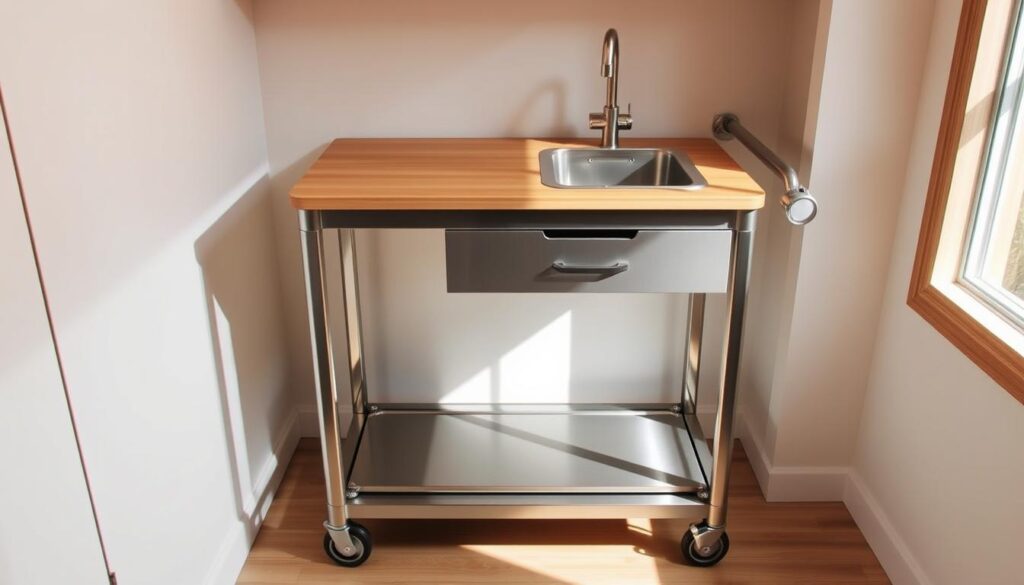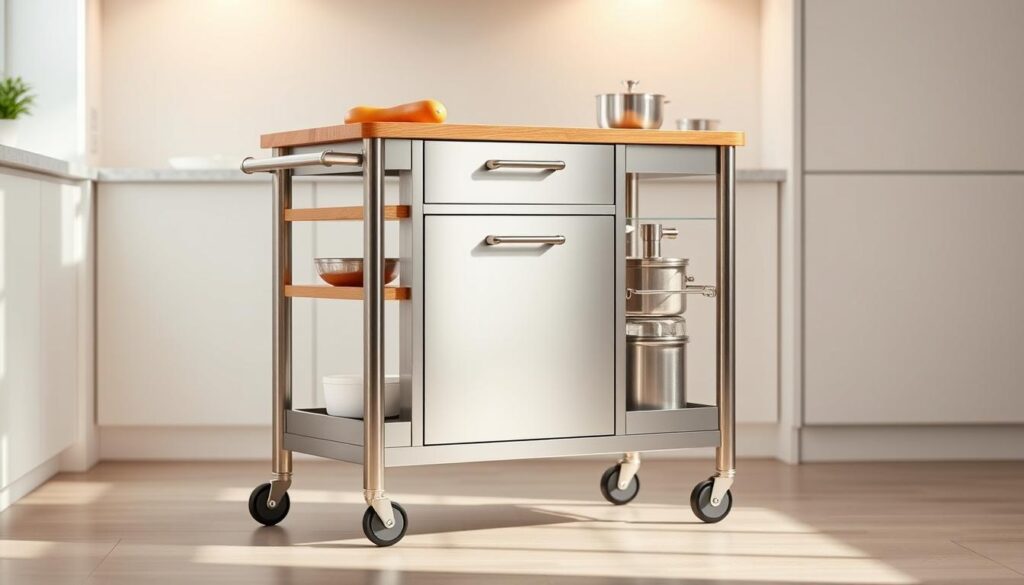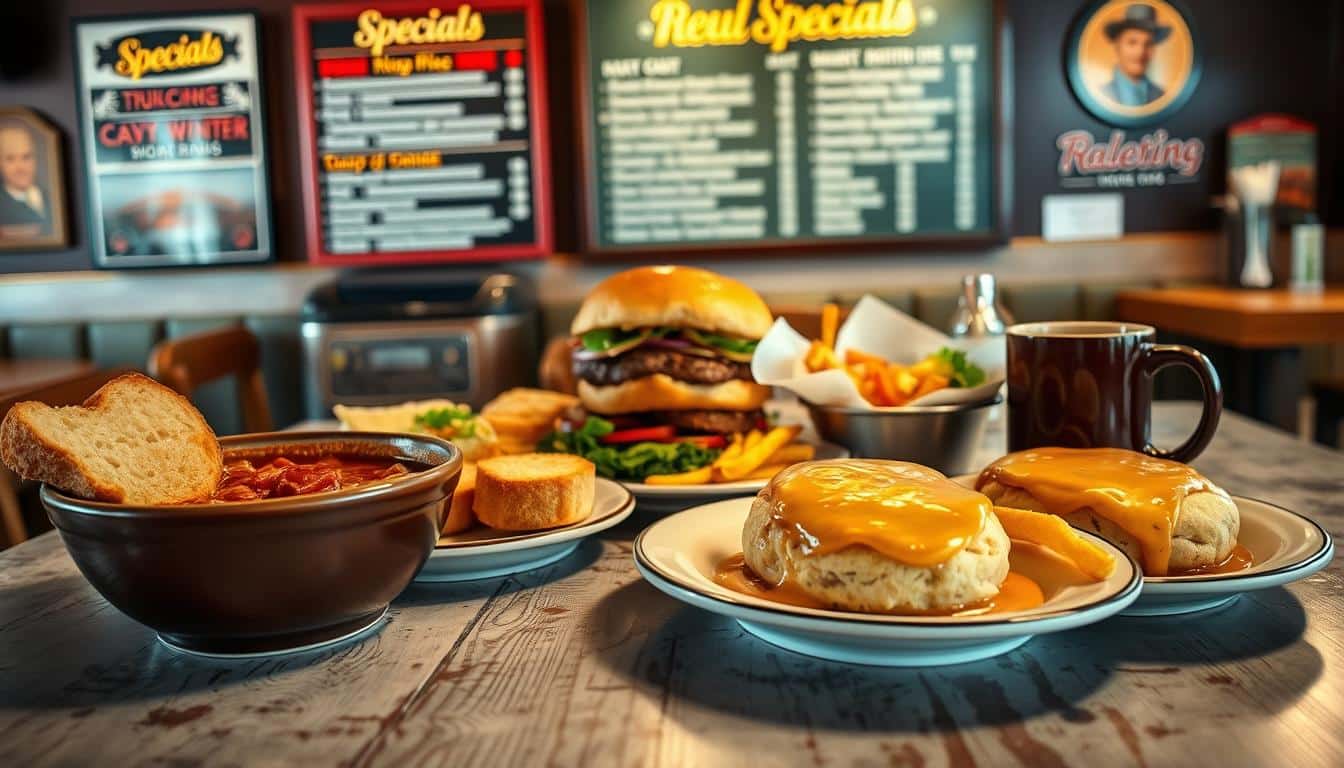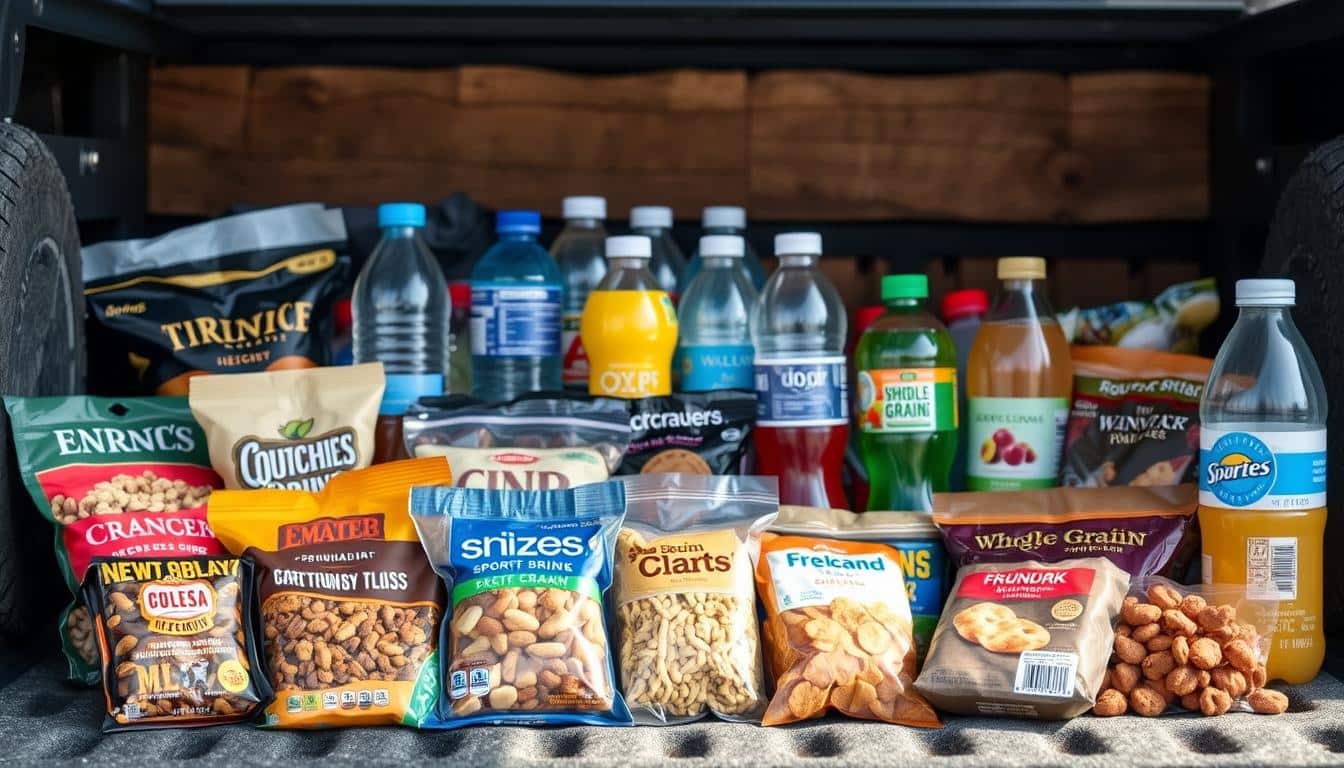A rolling kitchen makes small areas more flexible. You can use a mobile cart for hiding trash, adding space, or serving food. A kitchen island with wheels changes how we use tight spaces.
This article is for homeowners, people living in apartments, and catering experts in the U.S. It covers different mobile prep station types, strong materials, and whether to go DIY or buy professional. You’ll compare your options.
You’ll get advice on common uses, buying tips, and keeping your cart in good shape. By the end, picking the right rolling kitchen for your needs and budget will be easy.
What Is a Rolling Kitchen and Why It Matters
A rolling kitchen is a handy, moveable setup you can wheel anywhere. It includes a spot for prep, storing items, space for appliances, and ways to manage waste. It’s a versatile station that easily moves indoors or outdoors.
Core features
- Locking casters for stable positioning and safe mobility.
- Flat prep top made of butcher block, stainless steel, or laminate.
- Storage options such as drawers, cabinets, and open shelves.
- Pull-out trash or integrated bins to replace cabinet retrofits.
Who benefits
Home chefs seeking more prep area love its adaptability. People with small places bypass expensive cabinet changes by using this mobile option. Catering pros and food teams prefer mobile stations for scaling at events.
Common use cases
- Meal prep: put the cart near you to access tools and waste effortlessly.
- Entertaining: wheel a serving spot to where the fun is for easy hosting.
- Outdoor cooking: set up next to the grill to speed up cooking.
- Pop-ups and catering: build a mobile kitchen that fits any spot.
Knowing about rolling kitchens shows the perks of having a kitchen cart that moves. The examples given highlight why having flexibility, storage, and concealed bins is crucial in today’s kitchens.
Types of Mobile Cooking Carts and Rolling Kitchen Designs
A range of rolling kitchen types meets different needs, from tight urban flats to backyard grills. Choose by workspace, storage, and weather resistance. Below are common designs and how they fit real cooking routines.
Compact prep carts with butcher-block tops are perfect for small kitchens needing more counter space. A butcher block cart combines a solid wood top with a slender frame and wheels that lock. They’re often less than 24 inches wide, fit in tight spaces, and offer a durable surface for food prep.
Multi-drawer utility carts provide organized storage for kitchen tools, pans, and waste. Such carts have special sections for hiding trash and sorting recycling. They feature smooth drawers, customizable compartments, and a space just for trash bins, helping keep your kitchen neat and smell-free.
Outdoor-ready carts are built to withstand the elements. They may feature stainless steel, powder-coated supports, and waterproof wood tops for durability outside. For year-round use, pick a rolling cart designed with weatherproof construction including sealed edges and tough varnish, which minimizes upkeep.
- Compact prep: space-saving, usually with a butcher block cart top for food prep.
- Storage-focused: utility kitchen cart styles with drawers, shelves, and pull-out bins.
- Outdoor models: outdoor kitchen cart and weatherproof rolling cart builds for elements.
These carts vary in height and width to accommodate different appliances. Choose a taller cart for comfortable standing work or a shorter one to fit under countertops. Their design might include detachable shelves and adjustable containers for changing needs.
Materials, Build Quality, and Durability Considerations
The choice of materials is key to a rolling kitchen’s long-term performance. Consider how often you’ll use it, moisture exposure, and the weight of heavy items. Durable constructions lessen the need for future fixes and ensure reliable use for both home enthusiasts and professionals.
Stainless steel, hardwood, laminate, and powder-coated steel pros and cons
- Stainless steel is perfect for busy kitchens since it fights stains and is easy to clean. But, it can be pricey and may dent if hit by heavy items.
- Hardwood, like a maple butcher block, adds warmth and makes a great chopping area. Remember to oil it often and keep it dry to prevent damage.
- Laminate is easy on the wallet and requires little upkeep. Yet, it could chip or peel with rough use, especially with very hot items.
- Powder-coated steel comes in various colors and fights rust well. Be ready for minor touch-ups if the coating gets chipped, especially when used outside.
Wheel and caster types for indoor vs. outdoor mobility
- Soft rubber and polyurethane wheels are gentle on indoor floors, preventing scratches and moving easily on solid grounds.
- For outdoor use, go for bigger pneumatic or semi-pneumatic wheels. They navigate over grass and uneven surfaces well, making transport smoother.
- Stable work requires locking casters. Mixing swivel with fixed casters offers both easy movement and control in a straight path.
Load capacity and long-term maintenance tips
- It’s important to know the weight your cart can hold, which varies from 100 to over 500 lbs. Think about evenly spreading out heavy items.
- Maintenance can be easy: oil wooden parts, polish stainless steel, and secure loose screws regularly. Keeping casters clean avoids damage and ensures smooth rolling.
- Regular checks can prevent major repairs. Look out for any loose parts or damage and fix small problems quickly to keep your kitchen cart in top shape.
Features to Look For in a Rolling Kitchen Cart
Pick features for your rolling kitchen cart based on your cooking style and storage needs. A well-designed cart combines prep areas, waste options, and easy access to appliances for a seamless workflow. Here are key features to look for when getting or making a mobile kitchen station.
- Built-in cutting surfaces: Search for carts with built-in boards or butcher-block inserts that secure for safe chopping. A recessed slot helps with quick cleanups and keeps crumbs away from countertops.
- Pull-out waste solutions: Look for carts with pull-out trash options or a two-bin system for garbage and recycling. Two separate pull-outs are best, allowing one for recycling and the other for trash.
- Integrated water access: Carts with a built-in sink or a removable basin are great for easy rinsing and cleanups. They’re especially handy in rentals or for temporary setups.
- Adjustable storage: Carts with adjustable shelves or trays let you customize space for kitchen gadgets or large items. This feature makes it easy to store tall or wide cookware.
- Tool organization: Features like hooks, towel bars, and utensil organizers keep cooking tools within reach. These additions can speed up meal prep and keep your space tidy.
- Power and appliance fit: Choose carts designed for appliances, with space for cords and a spot for devices like mixers or cooktops. Remember to leave enough space for safety and air flow around appliances.
Always test a cart’s wheels and stability before purchase. Make sure the wheels lock securely to keep the cart in place when loaded. See how well different parts, like the cutting board and trash section, function together when the cart is full.
Consider how the cart will hold up over time. Opt for lasting surfaces, parts you can easily replace, and maybe a model with a sink for added convenience. A cart set for appliances adds versatility for using countertop devices without losing prep space.
Storage Solutions: Hiding Trash and Managing Recycling with a Rolling Kitchen
A rolling kitchen saves cabinet space and manages waste easily. It’s great for those who don’t like walking across the kitchen to throw things away. They can have a simple pull-out trash cart or a full-blown island with hidden spots for trash.
Integrated pull-out bins vs. freestanding bin solutions
Pull-out bins attach to the cart and keep trash bags in place. They look neat and don’t take up much space. You can use them with just one hand while cooking.
Freestanding bins just sit on a shelf. They’re cheaper and easy to replace. But they might move when you roll the cart around. Short-term needs? Try buckets or bins that are easy to switch out.
How a rolling cart can replace a cabinet retrofit for trash/recycling
Want to avoid losing storage and the hassle of installing a new cabinet? Use a rolling cart. It’s a trade-off that gives you extra prep space and hides trash without needing to change your kitchen cabinets.
Some opt for a basic utility cart from Walmart or a fancier one with sturdy tops. You can move it to where it helps you most and roll it away when you need space.
Design tips: dual-bin setups for recyclables and waste
- Choose bin sizes based on your needs. Go for 10–20 gallons to cut down on emptying them often.
- Have a dual-bin cart to keep recycling and trash separate right from the start.
- Pick liners and holders that are easy to change. This helps with smell and makes swapping them out a breeze.
- Make sure there’s air in the bin areas if you’re temporarily keeping food waste. This keeps smells down.
- Put bins away from where you prepare food to keep things clean and lessen walk-around.
- When people come over, use lids or sliding doors to hide the trash.
Choosing the right setup depends on your budget and lifestyle. If you want something easy to use every day, consider a pull-out trash cart or a dual-bin cart inside a rolling kitchen. These options help keep your kitchen tidy and functional.
How to Choose the Right Rolling Kitchen for Small Kitchens
Starting with precise measurements and priorities is key when picking a rolling kitchen for a small space. A well-chosen cart keeps walking paths open, offers extra workspace, and adds storage without making the space feel cramped.

Measuring and planning for walkways and work zones
Before you buy, measure the space. You should aim for at least 36 inches for main walkways. And 42–48 inches around the areas where you’ll be working a lot, if you can. Make sure to check the cart can move easily through doors, elevators, and tight corners.
Don’t forget to consider the height differences if you’ll move the cart from room to room. Also, you’ll want the cart’s work surface to be level with other counters for easier food prep.
Balancing prep surface, storage, and maneuverability
Think about if you need more counter space or more drawers. A bigger cart provides more workspace, but it might be hard to move in small spaces. A smaller cart is easier to maneuver and keeps aisles clear.
Choose a cart with wheels that lock to keep it stable while you’re using it. For carts that will get a lot of use, go for durable materials like stainless steel or hardwood tops. This way, your rolling kitchen will be both handy and not in the way.
Space-saving features: fold-down leaves and nesting carts
For extra prep space that disappears when you don’t need it, look for a cart with fold-down sides. Nesting carts are great because you can tuck them under the counter when they’re not in use, freeing up floor space.
If you love the idea of an island but need to save space, consider a folding island on wheels. Look for carts with removable shelves and collapsible racks to adjust to different uses.
- Measure first: door widths, aisle clearances, and counter heights.
- Prioritize locking casters for stability during prep.
- Choose fold-down or nesting designs to maximize daily flexibility.
Rolling Kitchen Carts for Professional Use and Catering
Pros need carts that can handle a lot and meet health standards. A commercial kitchen on wheels should be made of NSF-rated stuff. It should have sealed edges for easy cleaning and passing health checks. Pick finishes that are stain-resistant and easy to clean quickly.
Commercial-grade materials and sanitation standards
Choose carts with stainless steel tops and frames for best cleanliness. Stainless steel doesn’t rust and keeps bacteria from hiding in cracks. Smooth welds, curved edges, and safe finishes make cleaning easier. This helps staff stick to health department rules.
Scalable solutions for pop-up kitchens and food trucks
Catering teams benefit from carts that are easy to set up and pack away. Pick carts that can hold warming units, fridges, and have spots for plugging in. A cart for food trucks should be tough, carry a lot, and stay sturdy on the move.
- Stackable warmers and insulated carriers for holding food safely.
- Locking casters and reinforced frames for road travel.
- Portable refrigeration modules that clip into cart bays.
Customization options for branding and workflow optimization
Customize carts to show off your brand’s logo and colors. Choose designs that boost workflow: drawers where needed, hidden cord reels, and built-in power for cooking. Adjust drawer and shelf sizes for your tasks.
Get carts that are both mobile and strong to grow from small gigs to big pop-ups. The right carts lessen work, downtime, and keep food safe. They also make sure your mobile kitchen looks good at every event.
DIY and Custom Rolling Kitchen Ideas
Making a cabinet on wheels changes how small kitchens and rental spaces can be used. A few upgrades can turn a wheeled unit into something both beautiful and useful. Here are ideas that fit any budget, from low to high.
Start with a solid base
- Choose a strong utility cart from Walmart, IKEA, or Home Depot to begin turning cart parts into a durable station.
- Top it with a butcher-block, sealed for food safety, to make a real working surface.
Install useful hardware
- To add a trash function, use full-extension slides and bins for waste and recycling.
- Add racks for towels, hooks for utensils, and a magnet strip for knives to keep things handy but off the top.
Smart storage add-ons
- Build a spice area with easy-view, easy-reach shelves or pull-outs.
- Hang ladles and cups on pegboards on the sides to free up drawer space.
Budget builds
For cheaper projects, just upgrade the cart: add a sealed top, better casters, and bins. This way is cost-effective and can be undone for renters.
Premium custom cabinetry on casters
If you want it to feel built-in but movable, hire someone to make a custom cart. It will have smooth drawers, built-in waste systems, and finishes that match your kitchen.
Workflow and safety
Make sure there’s balance between work space, storage, and easy movement. Use locking casters to keep it still when needed. Store heavy things lower to keep it steady on the go.
Final tips
- Check the size of doors and paths before deciding on cart size.
- Practice with drawer slides and bins on scrap first to avoid mistakes.
- Think about having two bins to sort compost, recycle, and trash easily.
Where to Buy Rolling Kitchen Carts: Retailers and Online Marketplaces
When looking for a rolling kitchen cart, having a plan helps. First, think about the features you need. Then, pick stores that fit your budget and style. Here are some options to think about whether you need something for a small kitchen, for catering, or a custom piece.

Big stores like Walmart often have simple carts perfect for casual users. Home Depot and Lowe’s offer more durable carts with wood and metal. For tight spaces, check Amazon and Ikea for compact designs.
- Check product dimensions and caster specs before you buy.
- Test locking wheels and drawer fits when possible.
- Read reviews to confirm real-world durability.
Looking for top quality? Specialty makers like Winco and Regency offer carts for heavy use. Local shops can make custom carts that fit your exact needs. Always ask for samples and info on casters when ordering custom items.
- Request a mockup or shop drawings for custom rolling kitchen cabinets.
- Confirm warranty and lead times for bespoke builds.
If you’re watching your budget, consider used carts. You can find deals on Craigslist, Facebook Marketplace, and auction sites. Check each cart closely for any wear or damage before buying.
- Verify dimensions and clearance to fit your space.
- Check that drawers slide smoothly and locks work.
- Sanitize surfaces and replace worn casters if needed.
Uncertain? Look at carts from several retailers and, if possible, see them in person. This way, you can find the right mix of cost, ease of use, and storage. Buying with care avoids any unexpected issues and keeps your kitchen setup flexible.
Cost Ranges, Warranty, and Value Considerations
When picking out a rolling kitchen, think about cost versus use over time. Your budget, the materials used, and how you plan to use it will influence the price. Look beyond the initial cost and examine features, shipping, and assembly costs as well.
Basic rolling carts are pretty affordable. You can get a simple one for $50–$250 at major stores. These carts might have laminate tops, light steel, and simple wheels. At this price, don’t expect them to hold a lot of weight or come with much warranty.
- Typical kitchen cart cost at entry level: $50–$250
- Common trade-offs: simpler hardware, thinner tops, and basic finishes
If you’re willing to spend more, you can get better quality. For $250–$800, you find carts with solid wood or thick butcher-block tops. They also have better wheels, extra features like drawers, and stronger connections. These features make them more durable and easier to use every day.
- Typical kitchen cart cost at mid-range: $250–$800
- Added value: built-in bins, better hardware, and longer expected life
Top-tier and professional carts are built for serious use. They start at $800 and can go up over $2,500. These carts are made of stainless steel, can be custom fitted, and have wheels that can take heavy loads. They’re great for catering, restaurant use, or if you need something very sturdy at home.
- Typical kitchen cart cost at high end: $800–$2,500+
- What you get: commercial materials, custom sizing, and heavy-load capacity
Warranties matter a lot in seeing if you’re getting your money’s worth. Make sure parts and finishes are covered, and find out for how long. Before you buy, ask for the warranty details in writing.
When buying online, returns and shipping policies are critical. Look into the seller’s return policy to check on restocking fees and return shipping costs. Use any guarantees offered by the selling platform, your credit card, or store policies to safeguard your purchase.
- Compare total kitchen cart cost including shipping and assembly.
- Read warranty fine print for coverage limits and claim procedures.
- Verify the seller’s cart return policy and available buyer protections.
Wise buyers think about price now and value over time. Paying a bit more upfront for a kitchen cart could save you money. This is because it might last longer and have dependable warranty and return policies. Always ask questions, get promises in writing, and save your receipts for claims.
Maintenance, Cleaning, and Safety Tips for Rolling Kitchens
Make sure your rolling kitchen stays in top shape with easy, routine upkeep. Small steps can prevent big repair jobs and make cooking safe. Learn how to clean surfaces, care for casters, and maintain cleanliness in both busy households and small business kitchens.
Cleaning different surfaces
- Stainless steel: clean with gentle detergent and warm water, then dry to stop water spots. Use stainless polish lightly for extra shine and defense. Caring for your stainless steel keeps it looking new and stain-free.
- Wood and butcher block: apply food-safe mineral oil or conditioner every few weeks, based on how much you use it. Wipe with diluted vinegar to sanitize, but don’t let the wood get soaked. These steps stop warping or changing color in your butcher block.
- Laminate: use soft soap and water for cleaning. Stay away from rough scrubbers and harsh chemicals that harm the surface. Cleaning spots right away keeps laminate clean and looking good.
Caster upkeep and locking mechanisms
- Check casters each week for any trapped hair, crumbs, or dirt. Get rid of debris and clean the wheels with a moist cloth.
- Oil bearings as the manufacturer suggests. Taking care of casters reduces noise and slows down wear and tear.
- Lock the casters when you’re prepping food to keep the cart still. Secure locks protect your team and prevent accidents in small spaces.
Food-safety practices and sanitation
- Always sanitize after switching from raw meat to vegetables. Use different cutting boards, or ones that are color-coded, and clean them well with hot soapy water. Then, use a food-safe sanitizer.
- Empty and wash out trash areas often to avoid bad smells. A well-thought-out cart makes taking out and replacing bins easy, helping you keep things clean without hassle.
- Keep things that spoil in the fridge, not on the cart. Use your cart for getting food ready, not for storing it, to keep bacteria away.
To make sure your rolling kitchen continues to work well, follow a weekly checklist. Include taking care of surfaces, looking over casters, and dealing with garbage. Doing these small things regularly helps your equipment last longer and keeps your cooking space safe and efficient.
Conclusion
A mobile cooking cart can be a great choice instead of fixed cabinets. It gives you more space to prepare food, lets you hide trash, and is handy for cooking inside or outside. You can find utility carts at stores like Walmart that meet many family needs. Look for carts with dual pull-outs and strong tops.
Choosing the right kitchen cart means looking at the materials, wheels, and how it handles waste. Stainless steel, wood tops, and coated frames each have their ups and downs in terms of lasting and care. Make sure to measure your space and the appliances that need to fit. It’s also important to make sure the cart can be kept clean and stable.
When deciding, set a budget and compare options from stores, specialty brands, and custom makers. Think about what you really need, like dual trash bins, shelves that can be moved, and a top that is good with knives and machines. These tips will help you choose a cart that suits your everyday cooking, parties, or professional use.
Take care of your kitchen cart just like you would with any countertop. Clean it properly, look after the wheels, and be safe with food. The right choice and upkeep mean your cart can offer the perks of permanent cabinets without being stuck with them forever.
FAQ
What is a rolling kitchen and what core features should I expect?
Who benefits most from a rolling kitchen cart?
Can a rolling cart replace built-in trash and recycling cabinets?
What design types are available and which suits small kitchens?
What are the material tradeoffs I should consider?
How do I choose the right casters and wheels?
How much weight can a rolling kitchen cart hold?
Should I choose integrated pull-out bins or freestanding bins?
What features should I prioritize for food prep and appliance use?
How do I measure my space and plan for a rolling kitchen?
What maintenance does each surface require?
Are rolling kitchens suitable for professional or catering use?
Can I convert a retail utility cart into a rolling kitchen?
Where can I buy rolling kitchen carts and what should I check when buying used?
What are typical price ranges and what do they include?
How do I control odors and keep waste sanitary on a rolling cart?
What safety tips should I follow when using a rolling kitchen?
What are smart checklist items before purchasing a rolling kitchen?
Content created with the help of Artificial Intelligence.



